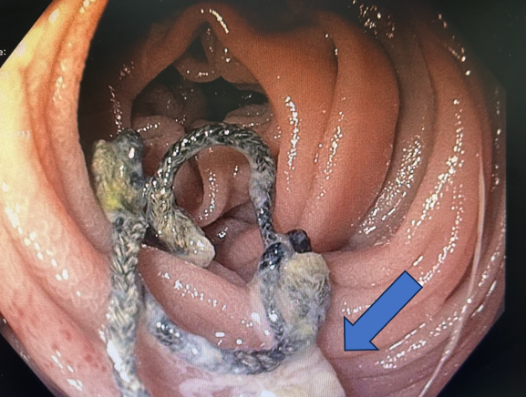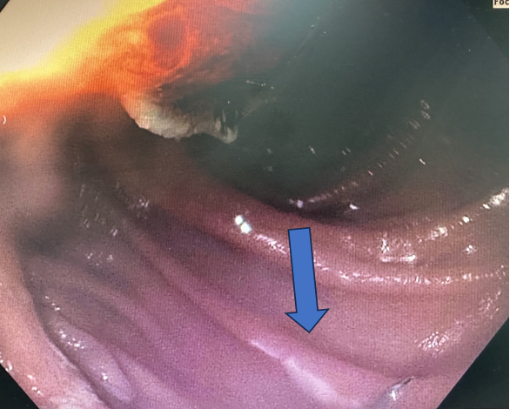Monday Poster Session
Category: General Endoscopy
P3010 - Jejunal Ulcers from Abrasion of Retained Suture Material After Roux-en-Y Gastric Bypass: A Rare but Treatable Cause of Abdominal Pain
Monday, October 27, 2025
10:30 AM - 4:00 PM PDT
Location: Exhibit Hall
.jpg)
William McGonigle, BS
University of Miami Miller School of Medicine
Miami, FL
Presenting Author(s)
William McGonigle, BS1, Myra Quiroga, MD2, Ami Panara Shukla, MD3
1University of Miami Miller School of Medicine, Miami, FL; 2University of Miami Miller School of Medicine at Jackson Memorial Hospital, Miami, FL; 3University of Miami Health System, Miami, FL
Introduction: Over 250,000 bariatric procedures were completed in the USA in 2022, with Roux-en-Y Gastric Bypasses (RYGB) being one of the most common operations. These operations manipulate the enteric pathway to exacerbate satiety or decrease absorption and are associated with well-known complications. Early complications include bleeding, wound infection, and coagulopathy. Late complications include marginal ulcers, small bowel obstruction, nutritional deficiencies, and dumping syndrome. Gastroenterologists care for many patients following RYGB. We present a case of a patient with nausea, emesis and abdominal pain after bariatric surgery that improved after cutting excess suture material.
Case Description/
Methods: A 56-Year-Old Female with a history of Diabetes Mellitus T2 who had RYGB 3 years prior presented to the GI clinic with daily episodes of nausea with yellow emesis and intermittent severe abdominal pain. After surgery, she lost 45 lbs and Hg A1C improved from 9.6 to 7.9. She had not responded to PPI trial and underwent outpatient EGD. EGD showed pouch extending 8 cm from Z line and 4.5 cm of excess suture material at the gastrojejunal anastomosis that was extending into the enteral tract. This suture material was causing direct mucosal irritation leading to multiple small jejunal ulcers. Endoscissors were used to cut 3.5 cm of the string that was subsequently removed with jumbo forceps. The patient started daily PPI. She was seen in clinic 6 weeks after the procedure and noted that her abdominal pain had resolved and her symptoms of nausea and emesis were less frequent. She was recommended behavioral modification to ensure small, frequent meals.
Discussion: Non-absorbable sutures are an established cause of marginal ulceration in surgical literature. Long sutures can also serve as an incidental nidus for food, blocking it from passing smoothly and resulting in symptoms like abdominal pain, nausea and emesis. Due to this, gastroenterologists should always consider EGD for evaluation of refractory symptoms after RYGB. Moreover, if an anastomosis is healed, suture material can be safely removed endoscopically. In our case, removing suture material significantly improved our patient’s quality of life.

Figure: Image 1: Arrow indicating the string attached to the suture that had been irritating the patients jejunal mucosa

Figure: Image 2: Image taken after string removal. Arrow indicating jejunal ulceration.
Disclosures:
William McGonigle indicated no relevant financial relationships.
Myra Quiroga indicated no relevant financial relationships.
Ami Panara Shukla indicated no relevant financial relationships.
William McGonigle, BS1, Myra Quiroga, MD2, Ami Panara Shukla, MD3. P3010 - Jejunal Ulcers from Abrasion of Retained Suture Material After Roux-en-Y Gastric Bypass: A Rare but Treatable Cause of Abdominal Pain, ACG 2025 Annual Scientific Meeting Abstracts. Phoenix, AZ: American College of Gastroenterology.
1University of Miami Miller School of Medicine, Miami, FL; 2University of Miami Miller School of Medicine at Jackson Memorial Hospital, Miami, FL; 3University of Miami Health System, Miami, FL
Introduction: Over 250,000 bariatric procedures were completed in the USA in 2022, with Roux-en-Y Gastric Bypasses (RYGB) being one of the most common operations. These operations manipulate the enteric pathway to exacerbate satiety or decrease absorption and are associated with well-known complications. Early complications include bleeding, wound infection, and coagulopathy. Late complications include marginal ulcers, small bowel obstruction, nutritional deficiencies, and dumping syndrome. Gastroenterologists care for many patients following RYGB. We present a case of a patient with nausea, emesis and abdominal pain after bariatric surgery that improved after cutting excess suture material.
Case Description/
Methods: A 56-Year-Old Female with a history of Diabetes Mellitus T2 who had RYGB 3 years prior presented to the GI clinic with daily episodes of nausea with yellow emesis and intermittent severe abdominal pain. After surgery, she lost 45 lbs and Hg A1C improved from 9.6 to 7.9. She had not responded to PPI trial and underwent outpatient EGD. EGD showed pouch extending 8 cm from Z line and 4.5 cm of excess suture material at the gastrojejunal anastomosis that was extending into the enteral tract. This suture material was causing direct mucosal irritation leading to multiple small jejunal ulcers. Endoscissors were used to cut 3.5 cm of the string that was subsequently removed with jumbo forceps. The patient started daily PPI. She was seen in clinic 6 weeks after the procedure and noted that her abdominal pain had resolved and her symptoms of nausea and emesis were less frequent. She was recommended behavioral modification to ensure small, frequent meals.
Discussion: Non-absorbable sutures are an established cause of marginal ulceration in surgical literature. Long sutures can also serve as an incidental nidus for food, blocking it from passing smoothly and resulting in symptoms like abdominal pain, nausea and emesis. Due to this, gastroenterologists should always consider EGD for evaluation of refractory symptoms after RYGB. Moreover, if an anastomosis is healed, suture material can be safely removed endoscopically. In our case, removing suture material significantly improved our patient’s quality of life.

Figure: Image 1: Arrow indicating the string attached to the suture that had been irritating the patients jejunal mucosa

Figure: Image 2: Image taken after string removal. Arrow indicating jejunal ulceration.
Disclosures:
William McGonigle indicated no relevant financial relationships.
Myra Quiroga indicated no relevant financial relationships.
Ami Panara Shukla indicated no relevant financial relationships.
William McGonigle, BS1, Myra Quiroga, MD2, Ami Panara Shukla, MD3. P3010 - Jejunal Ulcers from Abrasion of Retained Suture Material After Roux-en-Y Gastric Bypass: A Rare but Treatable Cause of Abdominal Pain, ACG 2025 Annual Scientific Meeting Abstracts. Phoenix, AZ: American College of Gastroenterology.

